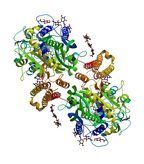Radiolabeled Small Molecules Show Promise in Prostate Cancer Early Detection
Radiolabeled small molecules targeting prostate-specific membrane antigen are well-tolerated tools for detection of metastatic prostate cancer, according to results of a phase I clinical trial.
Radiolabeled small molecules targeting prostate-specific membrane antigen (PSMA) are well-tolerated tools for detection of metastatic prostate cancer, according to data published in the March 2013 issue of the Journal of Nuclear Medicine.

Glutamate carboxypeptidase II structure, also known as prostate-specific membrane antigen
The study consisted of a phase I clinical trial utilizing an open-label, crossover design. Seven men aged 53 to 86 with confirmed prostate cancer and six healthy volunteers were selected for intravenous administration of two different agents designed to target PSMA, a well-known marker for prostate cancer.
Formal diagnosis and staging of prostate cancer relies on invasive and costly dissection techniques that can contribute to lower quality of life in patients. Noninvasive imaging techniques such as MRI can be helpful for determining the size of a primary lesion, but early metastatic disease is difficult to detect accurately due to lack of sensitivity. Radiolabel-enhanced imaging strategies may be able to improve visualization of disease.
Targeting PSMA has long been an attractive strategy for prostate cancer therapy. Virtually all prostate cancers express this protein, and elevated expression of PSMA is correlated to tumor grade, metastasis, and castration-resistance. This protein has enzymatic activity, which has allowed for the design of small molecule inhibitors for targeted therapy.
Two different agents, 123I-MIP-1072 and 123I-MIP-1095, were evaluated for pharmacokinetics and tumor uptake. These compounds had been previously designed to tightly bind PSMA. They were synthesized to incorporate radioactive iodine, allowing for visualization by whole-body scintigraphy and single photon emission computerized tomography.
The results showed that the effective doses of radiation received were 0.022 and 0.032 mSv/MBq for 123I-MIP-1072 and 123I-MIP-1095, respectively. Minor and temporary adverse events included chills, insomnia, constipation, and injection-site irritation. While the two drugs are able to bind PSMA with similar affinity, 123I-MIP-1072 demonstrated slightly better signal-to-noise ratio. This was due to the pharmacokinetic differences between the two drugs; 123I-MIP-1072 was more water-soluble and was therefore cleared more rapidly from the body. 123I-MIP-1095 was more hydrophobic and was maintained in nonspecific compartments longer. Imaging revealed that both inhibitors aided the detection of tumors. Metastatic disease was also detected in patients with previously-diagnosed tumor dissemination.
Overall, the two radiolabeled small molecules targeting PMSA were shown by this study to be effective visual aids for both primary and metastatic lesions. Both molecules were shown to have minor side effects that subsided with time. 123I-MIP-1072 was chosen in ongoing diagnostic clinical trials since it was cleared more rapidly, giving a cleaner signal. 123I-MIP-1095 is receiving ongoing attention as a delivery vehicle of radiotherapy since it was retained in the tumors to a greater extent and was not cleared from the blood as rapidly.